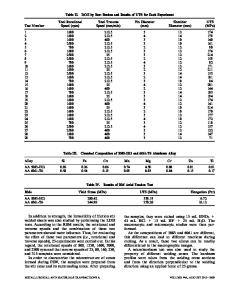Al/Cu Dissimilar Friction Stir Welding with Ni, Ti, and Zn Foil as the Interlayer for Flow Control, Enhancing Mechanical
- PDF / 10,086,411 Bytes
- 18 Pages / 593.972 x 792 pts Page_size
- 24 Downloads / 264 Views
INING of Al with Cu having differences in chemical, mechanical, and thermal properties[1] is often more challenging due to the formation of brittle[2] intermetallic compounds (IMCs). The successful joining of dissimilar metals, such as Al and Cu, is of great interest in chemical, nuclear, power generation, aerospace, transportation, and electronics industries due to the need for weight saving, performance enhancement, and cost reduction.[3] The fusion welding of Al alloys to Cu induces residual stress, cracking,[3] and brittle IMCs in the weld zone, making it difficult to obtain good weld quality. To overcome the aforementioned drawbacks, friction stir welding (FSW) has received much interest. Details of the FSW process can be found in the related article.[4] FSW is a solid-state thermomechanical[1] joining process and a suitable technique for joining dissimilar metals such as Al with Cu.[5] As the tool moves in the direction of the joint line, plasticized
PRAKASH KUMAR SAHU and SUKHOMAY PAL are with the Department of Mechanical Engineering, Indian Institute of Technology, Guwahati, Assam, 781039, India. Contact e-mail: [email protected] SURJYA K. PAL is with the Department of Mechanical Engineering, Indian Institute of Technology, Kharagpur, West Bengal, 721302, India. Manuscript submitted October 24, 2016. METALLURGICAL AND MATERIALS TRANSACTIONS A
material is stirred and forged behind the pin[6] trailing face. The combination of frictional heat and intense deformation caused by the tool produces a local forging and stirring effect,[7] which results in a high-quality metallurgical bond.[4] Joining of Al and Cu forms various IMCs, which have very high microhardness and brittleness at the interface of the joint. IMCs preferentially act as sources of microcracks and voids.[2,3] Similar to other welding processes, IMCs are also witnessed in the FSW process, which deteriorate the mechanical properties due to the inherent brittle nature of the IMCs. Therefore, preventing formation of an excess amount of IMCs in the dissimilar FSW process is extremely important. In order to minimize the formation of IMCs, choosing a proper interlayer[8] is always adoptable. With the application of a suitable interlayer between, two joining plates control the flow of the material and formation of IMCs that enhance the mechanical properties of the joint. It is well known that IMCs have been used as reinforcing particles[9] in metal matrix composites. Therefore, the formation of controlled amounts of IMCs is the key factor that can be obtained by insertion of a third material as the interlayer at the joint. There are limited research articles available related to the dissimilar FSW using the interlayer. The interlayer used in the case of the FSW process has a vital role to control the formation of IMCs to enhance the
mechanical and metallurgical properties. Chang et al.[10] observed enhanced mechanical and microstructural properties in the case of hybrid laser FSW of Al and Mg using Ni as the interlayer. Kuang et al.[1] focused on understand
Data Loading...











